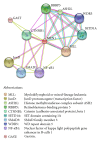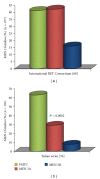Genetic and clinical features of multiple endocrine neoplasia types 1 and 2
- PMID: 23209466
- PMCID: PMC3503399
- DOI: 10.1155/2012/705036
Genetic and clinical features of multiple endocrine neoplasia types 1 and 2
Abstract
Multiple endocrine neoplasia (MEN) are clinical inherited syndromes affecting different endocrine glands. Three different patterns of MEN syndromes can occur (MEN 1, MEN 2A, and MEN 2B). MEN syndromes are very rare, affect all ages and both sexes are equally affected. MEN 1 is characterized by the neoplastic transformation of the parathyroid glands, pancreatic islets, anterior pituitary, and gastrointestinal tract. Heterozygous MEN 1 germline mutations have been detected in about 70-80% of patients with MEN 1. The mutations are scattered throughout the entire genomic sequence of the gene. MEN 1 patients are characterized by variable clinical features, thus suggesting the lack of a genotype-phenotype correlation. Therapeutical approaches are different according to the different endocrinopathies. The prognosis is generally good if adequate treatment is provided. In MEN 2 syndromes, the medullary thyroid cancer (MTC) is almost invariably present and can be associated with pheochromocytoma (PHEO) and/or multiple adenomatosis of parathyroid glands with hyperparathyroidism (PHPT). The different combination of the endocrine neoplasia gives origin to 3 syndromes: MEN 2A, MEN 2B, and FMTC. The clinical course of MTC varies considerably in the three syndromes. It is very aggressive in MEN 2B, almost indolent in the majority of patients with FMTC and with variable degrees of aggressiveness in patients with MEN 2A. Activating germline point mutations of the RET protooncogene are present in 98% of MEN 2 families. A strong genotype-phenotype correlation has been observed and a specific RET mutation may be responsible for a more or less aggressive clinical course. The treatment of choice for primary MTC is total thyroidectomy with central neck lymph nodes dissection. Nevertheless, 30% of MTC patients, especially in MEN 2B and 2A, are not cured by surgery. Recently, developed molecular therapeutics that target the RET pathway have shown very promising activity in clinical trials of patients with advanced MTC. MEN 2 prognosis is strictly dependent on the MTC aggressiveness and thus on the success of the initial treatment.
Figures




References
-
- Carney JA. Familial multiple endocrine neoplasia syndromes: components, classification, and nomenclature. Journal of Internal Medicine. 1998;243(6):425–432. - PubMed
-
- Marsh DJ, Gimm O. Multiple endocrine neoplasia: types 1 and 2. Advances in Oto-Rhino-Laryngology. 2011;70:84–90. - PubMed
-
- Brandi ML, Gagel RF, Angeli A, et al. Consensus: guidelines for diagnosis and therapy of MEN type 1 and type 2. Journal of Clinical Endocrinology and Metabolism. 2001;86(12):5658–5671. - PubMed
-
- Kloos RT, Eng C, Evans DB, et al. Medullary thyroid cancer: management guidelines of the American Thyroid Association. Thyroid. 2009;19(6):565–612. - PubMed
-
- Wohllk N, Schweizer H, Erlic Z, et al. Multiple endocrine neoplasia type 2. Best Practice and Research. 2010;24(3):371–387. - PubMed
LinkOut - more resources
Full Text Sources

